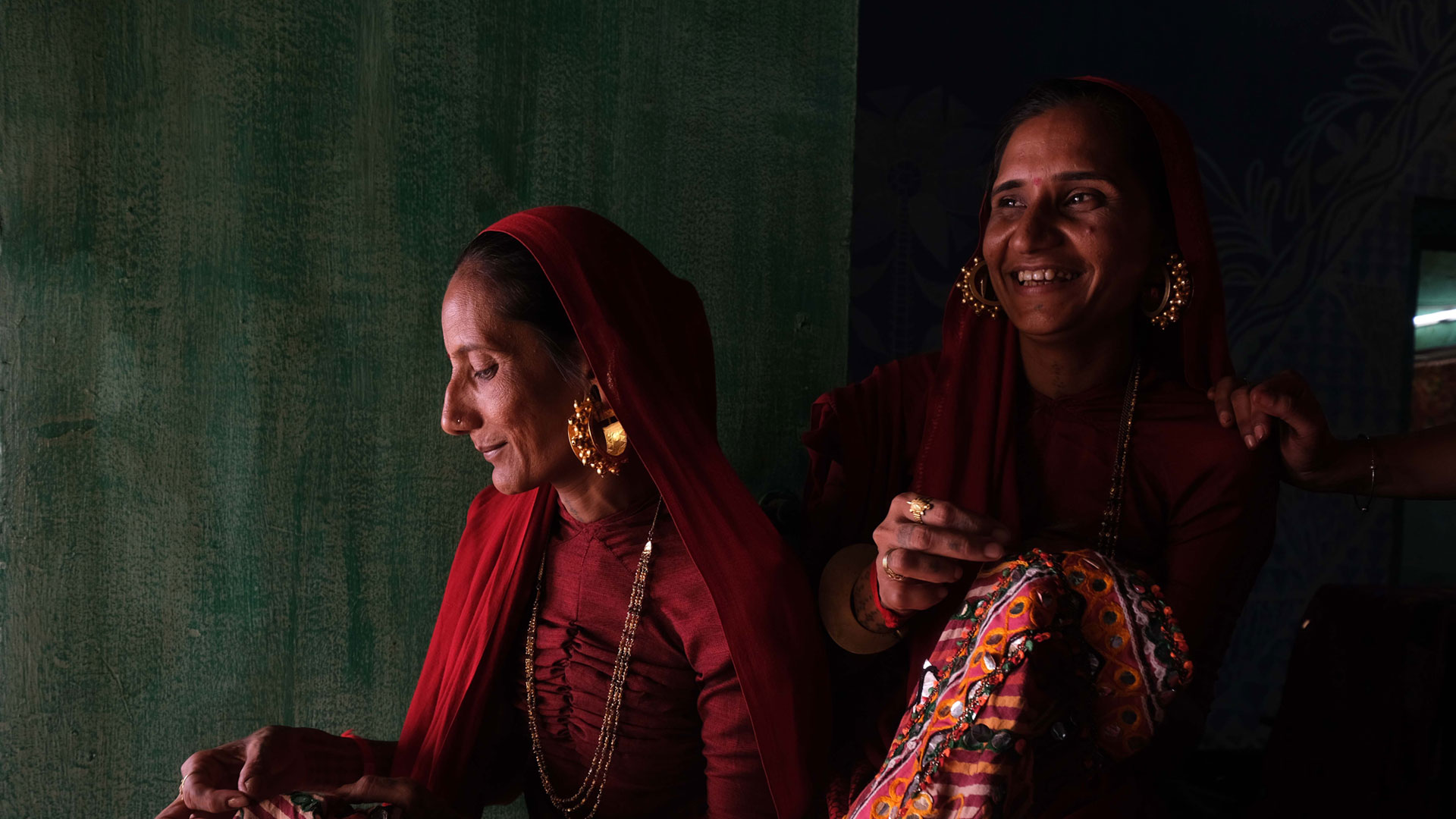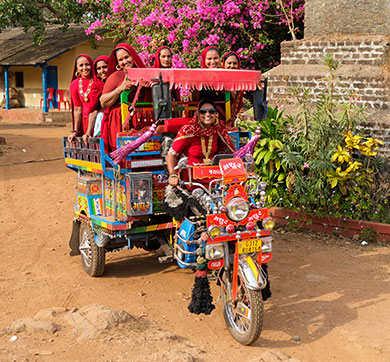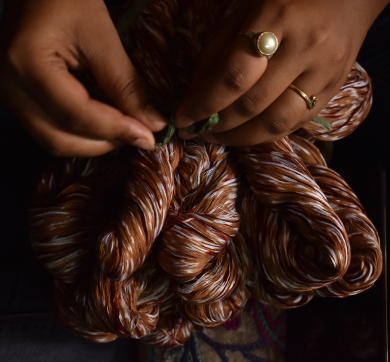September 2017 | 1170 words | 4-minute read
Okhai, the rural women’s collective supported by Tata Chemicals, has overcome multiple obstacles to carve a fashionable niche for itself in the apparel and lifestyle space.
In a remote corner of Gujarat on India’s far-western border, an idea that blends women’s empowerment, traditional artisanal skills and entrepreneurial zeal is going mainstream with marketing, to make the leap into a promising future. That’s the intent driving Okhai, a collective of about 900 women artisans that taps into the talent, culture and heritage of the region’s rural communities to create a branded range of apparel, accessories and home products.
Okhai takes its name from Okhamandal, the province in Jamnagar district where Tata Chemicals set up business operations back in 1939 as a manufacturer of soda ash. The brand came into formal existence in 2002 under the umbrella of the Tata Chemicals Society for Rural Development (TCSRD), the social development arm of the company. Okhai was registered as a trust in 2008 — the Okhai Centre for Empowerment — with artisans as members. Okhai has matured over the years to now reach an inflection point where it can be a viable and sustainable business. Modern marketing systems and processes have been crucial in powering the lift-off.
“We have a vision of creating 100,000 happy hands, which means making a difference in the lives of 50,000 women, and we’re geared up for that,” says Alka Talwar, chief, corporate social responsibility and sustainability officer at Tata Chemicals. “Meaningful impact takes time and we have set a milestone for ourselves: to touch the lives of 5,000 women in the coming five years.” Turning Okhai into a profitable and self-sustainable enterprise is vital in realising this objective.
The effort underway at Okhai absorbs the best of marketing practices and has been going on in right earnest for close to a decade. The brand has sought out a variety of ways to enhance its merchandising and sales numbers: product development, business processes, back-end systems, design capabilities, quality assurance and novel marketing initiatives. The goal, on the commercial side, has been straightforward: boost revenues, generate profits and make the business feasible and scalable. The inputs necessary to achieve that goal are in place. Okhai now has a business head, a design and sales office, ongoing engagements with the National Institute of Fashion Technology (NIFT) and National Institute of Design (NID), retail outlets in Ahmedabad and Mithapur and, importantly, a flourishing online presence. Not least, it has expanded its family to include artisans — and their handcrafted offerings — from places like Haldia in West Bengal and Babrala in Uttar Pradesh.
“We want to give the customer a certain product at a certain price, but we also want to pay our artisans more,” says Kirti Poonia, who helms Okhai. “We are faced with this challenge every day and we have managed to strike the right balance between the two.” The transition to online in 2014 and, since then, a deeper, further immersion in the digital world of business through social media has enabled the brand to find an equilibrium, while spreading the appeal of its products farther and wider than ever before.
Expanding the business
Okhai has reaped a rich harvest thanks to its digitalisation initiatives, securing 10 million in online sales in 2016-17, a 150% increase over the previous year. Playing significant roles in making the jump possible have been the brand’s 7,500 online customers, 66,000 followers on Facebook and the one million-plus sessions its website attracted over the course of the year. Okhai’s marketing campaigns have been critical in this context, as also in pushing retail sales of its apparel and home-decor products.
The ‘working women for working women’ promotion, which juxtaposes working women dressed in Okhai clothes with Okhai artisans — is an example of the brand’s marketing savvy. Executed at minimal cost using the collective’s own artisans and volunteers as models and in-house photographers, the campaign reached 22 million people, revealing in the process how Okhai had cottoned onto employing the advantages of digital media. The digital thrust has been taken to a new dimension following Okhai’s tie-up in late 2016 with Tata iQ, the big data and decision sciences company. Tata iQ will employ its cutting-edge solutions to optimise Okhai’s operations, improve the effectiveness of its digital marketing initiatives, explore channels for customer acquisition, and deliver insights on an integrated communications approach.
The turnover figures it has recorded are testimony, above all, to the excellence of Okhai’s products. To ensure quality improvements in design and rendering, the brand has created the Okhai Design Residency, a programme where professional designers partner Okhai workers to jointly make clothes and more. It also invests in upskilling its artisans by enrolling them at NIFT for workshops and by having experts from India and abroad engage with them.
It has been a long and eventful journey for Okhai from the time when the concept of a cooperative comprising woman artisans was mooted back in 1995. That was the year a team from TCSRD conducted a survey of 42 villages located around the Tata Chemicals manufacturing facility in Mithapur. The aim then was to lend a hand to drought-prone Okhamandal’s women, mainly from backward tribes, in moving from agriculture to alternative sources of livelihood.
Obstacle course
Today Okhai faces—and overcomes—business challenges like any other enterprise. For example, every Okhai artisan is graded for her skill level and takes anywhere between six months and a year to attain the required quality standards. This often leads to a supply constraint, an impediment for a business that has to be up to speed with demand. Besides, Okhai’s workers are spread across remote places in India, making the logistics of the operation challenging.
The profitability equation, critical as it is, has been calibrated to run parallel with the paramount purpose of improving the economic prospects of the artisans involved in the endeavour. Ensuring that its workers are adequately paid can sometimes mean the business has to be seen from the heart rather than the mind.
The everyday pressures it has to deal with have not dimmed Okhai’s prospects. The brand is now occupied with bringing under its canopy artisans from other locations where Tata companies have a presence. That means Taj Group’s weavers in Varanasi, Tata Global Beverages’ natural dye workers in Munnar, Tata Motors’ chikankari artisans in Lucknow and Tata Chemicals’ very own Masai craftswomen from Magadi in Kenya.
Okhai recorded revenues of 23 million in 2016-17 — a doubling of the turnover numbers from 2014-15 — on the back of a 50% reduction in costs and better efficiencies. Artisans earn anywhere between 500 to 10,000 a month depending on their involvement. And their social status has gone up higher still. But there’s so much more to accomplish in a business with its soul in the right place.
—Farah Dada













